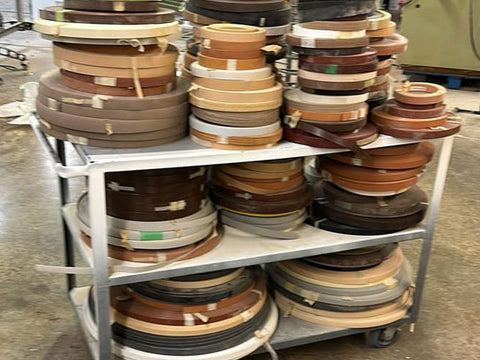Follow these tips and tricks to easily store your PVC edgebanding
Whether you’re in a commercial shop or a home studio, proper material storage is critical to shop organization, and efficient shop organization is a foundational aspect of maintaining high quality output. While it may seem simple, organizing your shop to accommodate changing materials, new skills, and potentially more customers requires substantial thought. This is especially true for storing materials that are visible on finished pieces, like edge banding and trim stock. Small dings or defects can render these materials unusable, and although PVC edgebanding is more durable than wood, its longevity can cause it to pile up in storage. Thankfully, though, with the right organization and rules of thumb in mind, it’s easy to develop the best PVC edgebanding storage system for your shop.
How is PVC edgebanding different from wood edgebanding?
PVC edgebanding is quite similar to its natural wood counterpart. The key difference is that PVC edge banding is made from durable PVC plastic (don’t worry, it can be matched to thousands of colors, textures, or patterns). Like traditional edgebanding, PVC edge banding is ideal for finishing and protecting the edges of furniture and casework.
Functionally, there are two key differences to keep in mind:
- PVC edgebanding provides a uniform finished look that can be matched across entire kitchens or built-ins. There are also PVC options that mimic the varied look of wood if you’re only after the enhanced durability of PVC, rather than the consistent aesthetics.
- PVC edgebanding is more durable than natural edgebanding, and better protects finished furniture from moisture, dirt, and debris.
Thankfully, the improvements offered by PVC edgebanding aren’t associated with any additional pesky storage requirements.
How to Store PVC Edgebanding
For expert insight on how to store PVC edgebanding, I interviewed one of Frama-Tech’s in-house PVC edgebanding experts, Ed Collins. ED has more than three decades of PVC edgebanding experience under his belt, spanning manufacturing and distribution to in-shop application and finishing. Ed has participated in every stage of the edgebanding cycle, and knows all the ins and outs of proper storage.
Step 1: A clean shop
Ed emphasized that the first, and perhaps most important step in the storage process is making sure your shop is clean, organized, and relatively dust free. This is important for the health and longevity of all your tools and materials, and is paramount to properly strategizing the best storage location in the shop. The key thing to remember here is that a relatively dust and debris free is ideal for storing edgebanding, PVC or wooden, because unwanted material can interfere with the adhesion process.
Step 2: Location! Location! Location!
The importance of location isn’t confined to real estate. Proper PVC edgebanding storage is just as much about strategic efficiency as it is about extending the life of your material. Finding the right location to store your edgebanding is a balancing act between being close to the edgebanding machine, or station if you do it by hand, and making sure you’re taking advantage of a low-dust area of your shop.
Whether you use a machine or do it by hand, the process of adhering PVC edgebanding generally doesn’t general a lot of dust or debris. Ed noted that the best placement is one that maximizes the flow of material from storage to adhesion to finishing, which may very well include spraying or other dust-free processes.
If you don’t have an area of your shop dedicated to edgebanding, mobile storage solutions are also great, especially if they have cabinets to keep the dust out.
Step 3: Surface support is king
Once you have selected a suitable spot to store your PVC edgebanding, you only have to adhere to one simple principle to optimize your edgebanding storage. It’s crucial to support as much of the edgebanding roll as possible - ideally, you can devise a solution that ensures each roll in storage is entirely supported on a flat surface.
It’s equally important to remember the reverse side of this principle as well, Ed cautioned. Hanging or unrolling your PVC edgebanding flat without any weight to keep it down not only exposes it to more dust and debris, but can also lead to warping that otherwise doesn’t occur in the PVC material. The same misshaping can occur if you store the rolls on their side like old school records.
But, as anyone who works in a shop can attest to, materials and tools have a nasty habit of building up. What started out as an honest attempt to organize and store your PVC edgebanding propelry can quickly turn into a tower waiting to fall over, as one user of a professionals forum revealed in the following picture:


While the mobile aspect of this poster’s storage solution is commendable, this isn’t an ideal situation for the edgebanding or for the user. When edgebanding is stacked up like this, it takes time to move everything around to get what you want. Keep in mind that a solid storage solution should be as efficient as possible.
As with many shop-related storage issues, Ed noted that the best solutions are self-generated. Rather than investing in expensive wall shelving or resorting to an increasingly-teetering stack, making a simple plywood rack that meets your specific needs while allowing for a certain degree of stock variation is a great way to go. A number of professionals on the forum responded with examples of their own storage shelving solutions; our favorite (pictured below) is simple yet highly functional.

What we like most about this unit is that it’s excellent design inspiration for anyone looking to make their own unique solution. We love the fact that each shelf is wide enough to accommodate large rolls when they first come in and is optimized for easy labeling and organization. Another great aspect of this storage solution is the fact that in addition to living on top of a workbench, you can place it on the floor near the edgebander, or even make it mobile by adding a few casters. Alternatively, if you have a particularly dusty shop you can tack on some cabinet doors or even a canvas flap without too much extra effort.

PVC Edgebanding Storage FAQs
Q: How does temperature impact PVC edge banding storage considerations?
A: Unlike wood, which will react to radiant humidity and temperature changes by expanding and contracting, PVC edgebanding won’t twist or warp out of shape during temperature fluctuations. If your shop is around room temperature (around 70 degrees give or take) you can store your PVC edge banding on open shelving without having to deal with any bags or other climate control measures.
However, our expert Ed Collins noted that PVC edgebanding thicker than 3MM may become stiff in colder temperatures, but not brittle. When it becomes stiff, a bit of radiant heat and gentle unrolling is all it takes to make it supple and workable again.
Q: Does PVC edgebanding have a shelf life?
A: No, PVC edgebanding doesn’t have a set shelf life. Unlike wood edgebanding, which can get brittle after 4-5 years of storage. If you have relatively high material turnover in your shop and solid storage systems, you won’t have to worry about your PVC or wood edgebanding becoming too brittle, warped, or otherwise unusable overtime.
If you’re ever unsure if your PVC edgebanding is in the right condition for use, make sure that it is supple enough to go through the edgebander and that the veneer is still securely attached. High quality PVC edgebanding should be just fine for years on end when properly stored.
Q: Do I need to keep my PVC edgebanding out of the sun?
A: Frama-Tech’s PVC edgebanding contains UV inhibitors that block the sun and preserve the finished look of the edgebanding, whatever that may be. Unlike certain wood species, like cherry, which will darken or yellow if left in direct sunlight for a prolonged period, high quality PVC edgebanding will stay the same color year after year.



















